Papers by Sasha Shafikhani
Cells
Hypertrophic scarring (HTS) is an aberrant form of wound healing that is associated with excessiv... more Hypertrophic scarring (HTS) is an aberrant form of wound healing that is associated with excessive deposition of extracellular matrix and connective tissue at the site of injury. In this review article, we provide an overview of normal (acute) wound healing phases (hemostasis, inflammation, proliferation, and remodeling). We next discuss the dysregulated and/or impaired mechanisms in wound healing phases that are associated with HTS development. We next discuss the animal models of HTS and their limitations, and review the current and emerging treatments of HTS.
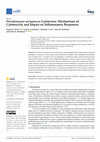
Cells
Pseudomonas aeruginosa is one of the most virulent opportunistic Gram-negative bacterial pathogen... more Pseudomonas aeruginosa is one of the most virulent opportunistic Gram-negative bacterial pathogens in humans. It causes many acute and chronic infections with morbidity and mortality rates as high as 40%. P. aeruginosa owes its pathogenic versatility to a large arsenal of cell-associated and secreted virulence factors which enable this pathogen to colonize various niches within hosts and protect it from host innate immune defenses. Induction of cytotoxicity in target host cells is a major virulence strategy for P. aeruginosa during the course of infection. P. aeruginosa has invested heavily in this strategy, as manifested by a plethora of cytotoxins that can induce various forms of cell death in target host cells. In this review, we provide an in-depth review of P. aeruginosa cytotoxins based on their mechanisms of cytotoxicity and the possible consequences of their cytotoxicity on host immune responses.
Endocrinology and Metabolic Syndrome, Nov 25, 2015
Cells
Pseudomonas aeruginosa is an important Gram-negative opportunistic pathogen which causes many sev... more Pseudomonas aeruginosa is an important Gram-negative opportunistic pathogen which causes many severe acute and chronic infections with high morbidity, and mortality rates as high as 40%. What makes P. aeruginosa a particularly challenging pathogen is its high intrinsic and acquired resistance to many of the available antibiotics. In this review, we review the important acute and chronic infections caused by this pathogen. We next discuss various animal models which have been developed to evaluate P. aeruginosa pathogenesis and assess therapeutics against this pathogen. Next, we review current treatments (antibiotics and vaccines) and provide an overview of their efficacies and their limitations. Finally, we highlight exciting literature on novel antibiotic-free strategies to control P. aeruginosa infections.

Scientific Reports
Recently, we described a phenomenon whereby apoptotic cells generate and release CrkI-containing ... more Recently, we described a phenomenon whereby apoptotic cells generate and release CrkI-containing microvesicles, which stimulate proliferation in surrounding cells upon contact to compensate for their own demise. We termed these microvesicles “ACPSVs” for Apoptotic Compensatory Proliferation Signaling microvesicles. As immune cells and a majority of current cancer therapeutics destroy tumor cells primarily by apoptosis, we conducted a small pilot study to assess the possibility that ACPSVs may also be generated in squamous cell carcinomas. We first evaluated a primary and a metastatic squamous cell carcinoma cancer cell lines for their ability to produce ACPSVs under normal and apoptotic conditions. We next conducted a pilot study to assess the occurrence of ACPSVs in solid tumors extracted from 20 cancer patients with squamous cell carcinomas. Both cancer cell lines produced copious amounts of ACPSVs under apoptotic conditions. Interestingly, the metastatic squamous cell carcinoma c...
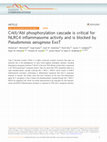
Nature Communications, 2022
Type 3 Secretion System (T3SS) is a highly conserved virulence structure that plays an essential ... more Type 3 Secretion System (T3SS) is a highly conserved virulence structure that plays an essential role in the pathogenesis of many Gram-negative pathogenic bacteria, including Pseudomonas aeruginosa. Exotoxin T (ExoT) is the only T3SS effector protein that is expressed in all T3SS-expressing P. aeruginosa strains. Here we show that T3SS recognition leads to a rapid phosphorylation cascade involving Abl / PKCδ / NLRC4, which results in NLRC4 inflammasome activation, culminating in inflammatory responses that limit P. aeruginosa infection in wounds. We further show that ExoT functions as the main anti-inflammatory agent for P. aeruginosa in that it blocks the phosphorylation cascade through Abl / PKCδ / NLRC4 by targeting CrkII, which we further demonstrate to be important for Abl transactivation and NLRC4 inflammasome activation in response to T3SS and P. aeruginosa infection.

eLife, 2022
Infection is a major co-morbidity that contributes to impaired healing in diabetic wounds. Althou... more Infection is a major co-morbidity that contributes to impaired healing in diabetic wounds. Although impairments in diabetic neutrophils have been blamed for this co-morbidity, what causes these impairments and whether they can be overcome, remain largely unclear. Diabetic neutrophils, isolated from diabetic individuals, exhibit chemotaxis impairment but this peculiar functional impairment has been largely ignored because it appears to contradict the clinical findings which blame excessive neutrophil influx as a major impediment to healing in chronic diabetic ulcers. Here, we report that exposure to glucose in diabetic range results in impaired chemotaxis signaling through the formyl peptide receptor (FPR) in neutrophils, culminating in reduced chemotaxis and delayed neutrophil trafficking in the wound of Leprdb (db/db) type two diabetic mice, rendering diabetic wound vulnerable to infection. We further show that at least some auxiliary receptors remain functional under diabetic cond...
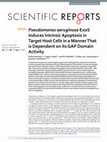
Scientific reports, Jan 19, 2018
Pseudomonas aeruginosa is a Gram-negative opportunistic pathogen that causes serious infections i... more Pseudomonas aeruginosa is a Gram-negative opportunistic pathogen that causes serious infections in immunocompromised individuals and cystic fibrosis patients. ExoS and ExoT are two homologous bifunctional Type III Secretion System (T3SS) virulence factors that induce apoptosis in target host cells. They possess a GTPase Activating Protein (GAP) domain at their N-termini, which share ~76% homology, and an ADP-ribosyltransferase (ADPRT) domain at their C-termini, which target non-overlapping substrates. Both the GAP and the ADPRT domains contribute to ExoT's cytotoxicity in target epithelial cells, whereas, ExoS-induced apoptosis is reported to be primarily due to its ADPRT domain. In this report, we demonstrate that ExoS/GAP domain is both necessary and sufficient to induce mitochondrial apoptosis. Our data demonstrate that intoxication with ExoS/GAP domain leads to enrichment of Bax and Bim into the mitochondrial outer-membrane, disruption of mitochondrial membrane and release o...

Developmental cell, Jun 19, 2017
Apoptosis has been implicated in compensatory proliferation signaling (CPS), whereby dying cells ... more Apoptosis has been implicated in compensatory proliferation signaling (CPS), whereby dying cells induce proliferation in neighboring cells as a means to restore homeostasis. The nature of signaling between apoptotic cells and their neighboring cells remains largely unknown. Here we show that a fraction of apoptotic cells produce and release CrkI-containing microvesicles (distinct from exosomes and apoptotic bodies), which induce proliferation in neighboring cells upon contact. We provide visual evidence of CPS by videomicroscopy. We show that purified vesicles in vitro and in vivo are sufficient to stimulate proliferation in other cells. Our data demonstrate that CrkI inactivation by ExoT bacterial toxin or by mutagenesis blocks vesicle formation in apoptotic cells and inhibits CPS, thus uncoupling apoptosis from CPS. We further show that c-Jun amino-terminal kinase (JNK) plays a pivotal role in mediating vesicle-induced CPS in recipient cells. CPS could have important ramifications...
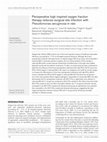
Journal of medical microbiology, Jan 14, 2016
Surgical site infection (SSI) remains one of the most important causes of healthcare-associated i... more Surgical site infection (SSI) remains one of the most important causes of healthcare-associated infections, accounting for ~17% of all hospital-acquired infections. Although, short-term perioperative treatment with high fraction of inspired oxygen (FiO2) has shown clinical benefits in reducing SSI in colorectal resection surgeries, the true clinical benefits of FiO2 therapy in reducing SSI remain unclear because randomized controlled trials on this topic have yielded disparate results and inconsistent conclusions. To date, no animal study has been conducted to determine the efficacy of short-term perioperative treatments with high (FiO2 > 60%) versus low (FiO2 < 40%) oxygen in reducing SSI. In this report, we designed a rat model for muscle surgery to compare the effectiveness of short-term perioperative treatments with high (FiO2 = 80%) versus a standard low (FiO2 = 30%) oxygen in reducing SSI with Pseudomonas aeruginosa-- one of the most prevalent Gram-negative pathogens, re...
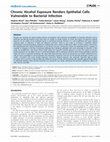
PLoS ONE, 2013
Despite two centuries of reports linking alcohol consumption with enhanced susceptibility to bact... more Despite two centuries of reports linking alcohol consumption with enhanced susceptibility to bacterial infections and in particular gut-derived bacteria, there have been no studies or model systems to assess the impact of long-term alcohol exposure on the ability of the epithelial barrier to withstand bacterial infection. It is well established that acute alcohol exposure leads to reduction in tight and adherens junctions, which in turn leads to increases in epithelial cellular permeability to bacterial products, leading to endotoxemia and a variety of deleterious effects in both rodents and human. We hypothesized that reduced fortification at junctional structures should also reduce the epithelial barrier's capacity to maintain its integrity in the face of bacterial challenge thus rendering epithelial cells more vulnerable to infection. In this study, we established a cell-culture based model system for long-term alcohol exposure to assess the impact of chronic alcohol exposure on the ability of Caco-2 intestinal epithelial cells to withstand infection when facing pathogenic bacteria under the intact or wounded conditions. We report that daily treatment with 0.2% ethanol for two months rendered Caco-2 cells far more susceptible to wound damage and cytotoxicity caused by most but not all bacterial pathogens tested in our studies. Consistent with acute alcohol exposure, long-term ethanol exposure also adversely impacted tight junction structures, but in contrast, it did not affect the adherens junction. Finally, alcohol-treated cells partially regained their ability to withstand infection when ethanol treatment was ceased for two weeks, indicating that alcohol's deleterious effects on cells may be reversible.
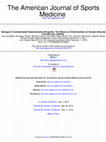
The American Journal of Sports Medicine, 2014
Background: Because chondrocyte viability is imperative for successful osteochondral allograft tr... more Background: Because chondrocyte viability is imperative for successful osteochondral allograft transplantation, sterilization techniques must provide antimicrobial effects with minimal cartilage toxicity. Chlorhexidine gluconate (CHG) is an effective disinfectant; however, its use with human articular cartilage requires further investigation. Purpose: To determine the maximal chlorhexidine concentration that does not affect chondrocyte viability in allografts and to determine whether this concentration effectively sterilizes contaminated osteoarticular grafts. Study Design: Controlled laboratory study. Methods: Osteochondral plugs were subjected to pulse lavage with 1-L solutions of 0.002%, 0.01%, 0.05%, and 0.25% CHG and cultured for 0, 1, 2, and 7 days in media of 10% fetal bovine serum and antibiotics. Chondrocyte viability was determined via LIVE/DEAD Viability Assay. Plugs were contaminated with Staphylococcus aureus and randomized to 4 treatment groups. One group was not conta...
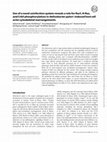
FEMS Immunology & Medical Microbiology, 2007
The Helicobacter pylori CagA protein induces profound morphological changes in the host cytoskele... more The Helicobacter pylori CagA protein induces profound morphological changes in the host cytoskeleton and cell scattering, but the signalling involved is poorly understood. Pseudomonas aeruginosa also affects host actin cytoskeleton in a variety of ways by injecting the ExoS and ExoT toxins which encode N-terminal GTPase activating protein and C-terminal ADP-ribosyltransferase (ADPRT) activities. In this study we developed a novel coinfection assay to gain new insights into CagA effector protein functions. We found that P. aeruginosa injecting either ExoT or ExoS efficiently prevented the H. pylori-induced scattering phenotype. Both the Rho-GAP and the ADPRT domains of ExoS were needed to block the H. pylori-induced actin cytoskeletal rearrangements, whereas either domain of ExoT was sufficient for this activity. This strategy revealed common pathways subverted by different pathogens, and aided in the definition of signalling cascades that control the CagA-mediated cell scattering and elongation. We identified Crk adapter proteins, Rac1 and H-Ras, but not RhoA or Cdc42, which are the ExoS and/or ExoT targets, as crucial components of the CagAinduced phenotype. In addition, we show that ADP-ribosylation of CrkII by ExoT blocks phosphorylation of CrkII at Y-221, which is also important for the CagAinduced signalling.

We describe a PCR-based method for the generation of plasmid multimers that can be directly trans... more We describe a PCR-based method for the generation of plasmid multimers that can be directly transformed into Bacillus subtilis with very high efficiency. This tech-nique is particularly useful for the genera-tion of large libraries of randomly mutage-nized genes, which are required for the optimization of enzymes by directed evolu-tion. We subjected the gene coding for the protease subtilisin to six consecutive rounds of PCR at three different levels of muta-genicity. The resulting 18 populations were cloned using our PCR multimerization pro-tocol, and the mutation frequencies were determined by DNA sequencing. The result-ing data demonstrate that the mutation fre-quency during PCR can be controlled by adding varying concentrations of man-ganese chloride to the reaction mixture. We observed a bias in the type of base pair changes with A and T being mutated much more frequently than C and G. We deter-mined the fraction of active clones in all populations and found that its natural lo...
The online version of this article can be found at: DOI: 10.1177/0363546513519950 2014 42: 973 or... more The online version of this article can be found at: DOI: 10.1177/0363546513519950 2014 42: 973 originally published online February 11, 2014Am J Sports Med
Journal of Oncology Translational Research

Cellular Microbiology
Recently, we demonstrated that Pseudomonas aeruginosa Exotoxin T (ExoT) employs two distinct mech... more Recently, we demonstrated that Pseudomonas aeruginosa Exotoxin T (ExoT) employs two distinct mechanisms to induce potent apoptotic cytotoxicity in a variety of cancer cell lines. We further demonstrated that it can significantly reduce tumour growth in an animal model for melanoma. During these studies, we observed that melanoma cells that were transfected with ExoT failed to undergo mitosis, regardless of whether they eventually succumbed to ExoT‐induced apoptosis or survived in ExoT's presence. In this report, we sought to investigate ExoT's antiproliferative activity in melanoma. We delivered ExoT into B16 melanoma cells by bacteria (to show necessity) and by transfection (to show sufficiency). Our data indicate that ExoT exerts a potent antiproliferative function in melanoma cells. We show that ExoT causes cell cycle arrest in G1 interphase in melanoma cells by dampening the G1/S checkpoint proteins. Our data demonstrate that both domains of ExoT; (the ADP‐ribosyltransferase (ADPRT) domain and the GTPase activating protein (GAP) domain); contribute to ExoT‐induced G1 cell cycle arrest in melanoma. Finally, we show that the ADPRT‐induced G1 cell cycle arrest in melanoma cells likely involves the Crk adaptor protein. Our data reveal a novel virulence function for ExoT and further highlight the therapeutic potential of ExoT against cancer.

Infection is a major co-morbidity that contributes to impaired healing in diabetic wounds. Althou... more Infection is a major co-morbidity that contributes to impaired healing in diabetic wounds. Although impairments in diabetic neutrophils have been blamed for this co-morbidity, what causes these impairments and whether they can be overcome, remain largely unclear. Diabetic neutrophils, extracted from diabetic individuals, exhibit chemotaxis impairment but this peculiar functional impairment has been largely ignored because it appears to contradict the clinical findings which blame excessive neutrophil influx (neutrophilia) as a major impediment to healing in chronic diabetic ulcers. Here, we report that exposure to glucose in diabetic range results in impaired chemotaxis signaling through the FPR1 chemokine receptor in neutrophils, culminating in reduced chemotaxis and delayed neutrophil trafficking in wound in diabetic animals, and rendering diabetic wound vulnerable to infection. We further show that at least some auxiliary chemokine receptors remain functional under diabetic condi...
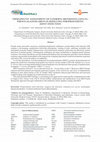
European Cells and Materials
Despite many preventive measures, including prophylactic antibiotics, periprosthetic joint infect... more Despite many preventive measures, including prophylactic antibiotics, periprosthetic joint infection (PJI) remains a devastating complication following arthroplasty, leading to pain, suffering, morbidity and substantial economic burden. Humans have a powerful innate immune system that can effectively control infections, if alerted quickly. Unfortunately, pathogens use many mechanisms to dampen innate immune responses. The study hypothesis was that immunomodulators that can jumpstart and direct innate immune responses (particularly neutrophils) at the surgical site of implant placement would boost immune responses and reduce PJI, even in the absence of antibiotics. To test this hypothesis, N-formyl-methionyl-leucyl-phenylalanine (fMLP) (a potent chemoattractant for phagocytic leukocytes including neutrophils) was used in a mouse model of PJI with Staphylococcus aureus (S. aureus). Mice receiving intramedullary femoral implants were divided into three groups: i) implant alone; ii) imp...

Uploads
Papers by Sasha Shafikhani